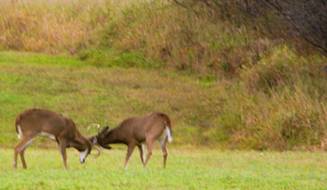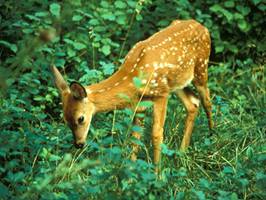The White-Tailed Deer
Reproduction

Male (buck) deer have antlers for the main purpose of fighting other bucks during the breeding season. They also use their antlers to mark their territory by rubbing them on trees; these are known as “Buck Rubs”. There are also scent glands in the eyes of deer which informs other bucks or does in his territory of his particular status. This breeding season begins in November and is called the rut season. A doe's estrous period usually starts in November, which initiates the bucks' interest. A doe will be in heat for about 30 hours and if there is no conception or copulation the doe will begin her heat cycle in 28 to 30 days. There are four periods if a doe does not conceive in the beginning periods odds are she will in one of the last two. The level of intensity of the rut varies in different parts of the country. The Fights between bucks determines who will mate with specific doe(s). White-tailed deer are polygamous and a big buck will mate with many doe, but the doe will only court one buck, occasionally a doe will have more than one mate. Deer reproduce sexually and there is internal fertilization.
A deer's gestation period is 200 to 205 days, most of the fawns being born in the latter part of May or the first part of June. A doe giving birth for her first time will have a single fawn, thereafter she will have twins. Nutrition play key role in lactation after pregnancy and during pregnancy while the fetus is developing. At birth a baby deer weighs about 4 to 5 pounds. The mother doe will leave her new born(s) for many hours while she forages for food.

Female deer will nurse their young several times a day until the fawns are strong enough to join the herd. The spots are retained until the fawns molt in early fall by which time they are usually weaned. Normally, sexual maturity is not reached in females until two years but occasionally, when food conditions are plentiful, female fawns mate the first fall and produce offspring the following spring when they themselves are only 1 year old. Two strong and well nourished deer can produce as much as 30 offspring in a seven year period.